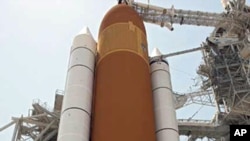People are flocking to the central Florida coast for Friday's scheduled launch of the space shuttle Endeavour, the second to last launch of a shuttle as NASA brings the three-decade-old program to an end.
The space agency is expecting around 700,000 people to be on hand for the event Friday evening, including US Representative Gabrielle Giffords, the wife of shuttle commander Mark Kelly. She is still recovering from a wound to the head suffered in a shooting rampage in her home district in Arizona back in January. Her presence adds special emotional touch to what many regard as a significant moment for the US space program.
As crews prepare the space shuttle for launch at the Kennedy Space Center, Weather Officer Kathy Winters is keeping an eye on the slow-moving front that has worked its way across US southern states in recent days spawning severe thunderstorms and devastating tornadoes.
"We are expecting that to move down into central Florida," said Kathy Winters. "Now, it won't have the energy it has had and it won't be producing the severe weather as widespread as it has been doing the last couple of days, but we do expect that there could be an isolated severe thunderstorm along the front."
She said this concern caused her to move the probability of a weather-related delay in the launch from 20 percent to 30 percent. NASA officials say a slight delay in fueling the shuttle's external tank would not be a problem and there is a four-hour leeway built into the schedule.
The launch of Endeavor Friday will be a bittersweet event for astronauts, flight crews, space and science enthusiasts as well as those who have followed the progress of Congressswoman Gabrielle Giffords since she was severely wounded nearly four months ago. This launch, commanded by her husband, Mark Kelly, and the launch of the space shuttle Atlantis scheduled for late June will mark the end of an era and the beginning of a new, somewhat uncertain phase for the US space program.
Giffords, who has witnessed two previous launches in which her husband flew, wanted to be present for the start of his final shuttle mission even though she is still healing from her head wound. Doctors who have been working with her at a rehabilitation facility here in Houston approved her trip to Florida. News video shot from a distance Wednesday showed Giffords walking with some assistance to the airplane that took her to Florida. Doctors and therapists will be on hand with her the whole time at the Kennedy Space Center and she will be in a restricted viewing area. President Barack Obama is also scheduled to attend the launch, but NASA has not indicated where he will be.
Endeavour will carry the six-member crew to the International Space station and also carry out a number of experiments on its two-week-long mission, including the testing of three small satellites, each small enough to fit in the palm of a hand. If the experiment carried out as the shuttle travels to the space station is successful it could lead to the development of tiny satellites that could be deployed in space for a small fraction of the cost of deploying a conventional satellite.
The most important part of the mission is the delivery of the Alpha Magnetic Spectrometer-2 to the International Space Station. It will be used for a study of cosmic rays and is expected to be operational for around 10 years.
As the Endeavour launch was being prepared, NASA held a news conference with representatives of private companies developing their own space vehicles, with the goal of providing transport into space for US astronauts by the middle of this decade. NASA has awarded more than $269 billion to four private US companies to help them spur development of their technologies.
The chairman of one of the companies, Mark Sirangelo of the Sierra Nevada company, hailed the accomplishments of the US Space Shuttle program for opening the way for this next phase in space exploration.
"I have heard and I have read many times in the last week about the end of the space shuttle program," said Mark Sirangelo. "From my perspective I do not see it as an end. I see it as the beginning of the next step. I think space shuttle was a bridge to move forward. Our vehicle is based, in large part, on the successes, on the triumphs, on the challenges, and the pain that has been done in the space shuttle program."
The Colorado-based Sierra Nevada company received $80 million from NASA to develop its Dream Chaser space plane. Other companies with similar vehicles in development with initial funding from NASA are Boeing, based in Chicago, California-based Space Exploration Technologies, or Space X, and Blue Origin, which is based in the northwest US state of Washington.
Space Shuttle Endeavor Ready for its Last Mission
- By Greg Flakus














